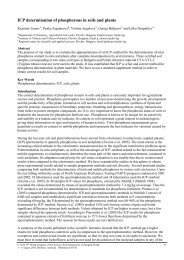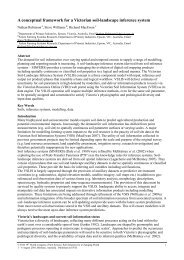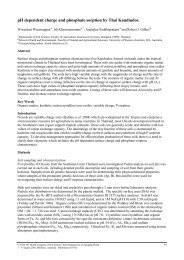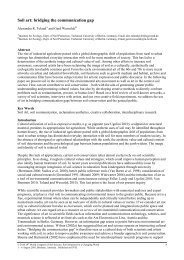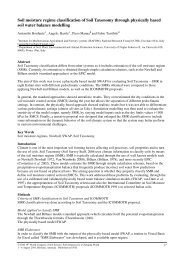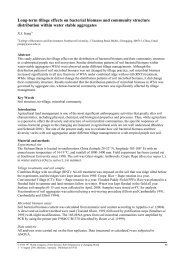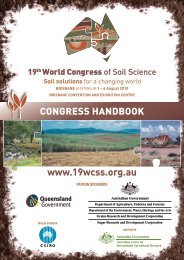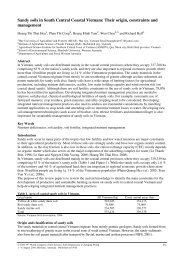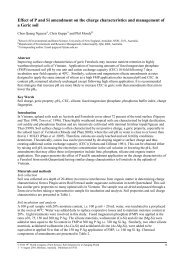Sivakumaran Siva (Sivalingam)
Sivakumaran Siva (Sivalingam)
Sivakumaran Siva (Sivalingam)
Create successful ePaper yourself
Turn your PDF publications into a flip-book with our unique Google optimized e-Paper software.
Effect of charcoal (biochar) amendments in Manawatu sandy-loam soil (New<br />
Zealand) on white clover growth and nodulation<br />
<strong>Siva</strong> (<strong>Siva</strong>lingam) <strong><strong>Siva</strong>kumaran</strong> a , Shivan <strong><strong>Siva</strong>kumaran</strong> c , Paramsothy Jeyakumar b , Carmen Diana Mellisho<br />
Salas d , Markus Deurer a , Ian McIvor a , and Brent Clothier a<br />
a Sustainable Production: Soil, Water & Environment and Systems Modelling & Biometrics, The New Zealand Institute for Plant &<br />
Food Research Limited (Plant & Food Research), Palmerston North, 4442, New Zealand. siva.sivakumaran@plantandfood.co.nz<br />
b Soil and Earth Sciences, Institute of Natural Resources, Massey University, Palmerston North, 4442, New Zealand<br />
c Palmerston North Boys’ High School, P O Box 4049, Palmerston North 4442, New Zealand<br />
d Dpto. Riego. Centro de Edafología y Biología Aplicada del Segura (CSIC). P. O. Box 160, E-30100 Espinardo (Murcia), Spain.<br />
Abstract<br />
New Zealand primary industries such as dairying produce significant amounts of greenhouse gases,<br />
particularly methane. Storage of carbon in agricultural soils in the form of biochar has been proposed as a<br />
means of offsetting carbon emissions. Biochar could also improve soil conditions for plant growth. This<br />
paper reports the effects of biochar as a soil amendment added to a Manawatu sandy-loam soil, on the soil<br />
pH, soil carbon and nitrogen, mineralisable nitrogen and hot water extractable carbon, together with root and<br />
shoot growth for white clover (Trifolium repens var Emerald). Biochar was added to the soil in differing<br />
proportions. The proportions were 0:100, 20:80, 40:60, 60:40, 80:20 and 100:0, biochar to soil. Each of these<br />
six treatments was replicated four times and set up in a pot trial in a glass house configured with a<br />
Randomised Complete Block Design (RCBD). The addition of biochar reduced the growth of white clover<br />
shoot and root dry matter. The increased carbon content of soil and reduced supply of plant nutrients may be<br />
the reason for the reduced growth of white clover and biochar increased the pH.<br />
Key Words<br />
Biochar, carbon, soil properties, white clover, nitrogen, Randomised Complete Block Design (RCBD).<br />
Introduction<br />
The release of carbon (C) into the atmosphere far outweighs the fixation of carbon by soil organisms.<br />
Considering the incessantly increasing quantity of carbon dioxide (CO 2 ) in the atmosphere, retaining carbon<br />
in the soil is a concern now and in the future. A proposed simple way of retaining carbon in the soil is<br />
through addition of biochar. Biochar is a term reserved for the plant biomass derived materials contained<br />
within the black carbon (BC) continuum. This definition includes chars and charcoal, and excludes fossil fuel<br />
products or geogenic carbon (Lehmann et al. 2006). Materials forming the BC continuum are produced by<br />
partially combusting (charring) carbonaceous source materials, e.g. plant tissues (Schmidt and Noack 2000),<br />
and have both natural as well as anthropogenic sources. Depending on the temperatures reached during<br />
combustion and the species identity of the source material, a biochar’s chemical and physical properties may<br />
vary (Keech et al. 2005). For example, coniferous biochars generated at lower temperatures, e.g. 350°C, can<br />
contain larger amounts of available nutrients, while having a smaller sorptive capacity for cations than<br />
biochars generated at higher temperatures, e.g. 800°C (Gundale and DeLuca 2006). However, the effects of<br />
biochar as a soil supplement are not fully understood; and need further investigation to determine how it<br />
confers benefits on soil.<br />
Figure 5. White Clover in RCBD<br />
© 2010 19 th World Congress of Soil Science, Soil Solutions for a Changing World<br />
1 – 6 August 2010, Brisbane, Australia. Published on DVD.<br />
25
A proposed way of testing biochar as a beneficial soil amendment involves investigating its effect on white<br />
clover growth. White clover (Trifolium repens; Figure.1) is a key component of New Zealand pastural<br />
agriculture, which is dependent on an inexpensive, high quality, feed source. In pastures, white clover<br />
provides a cheap, continual source of nitrogen (N), has high nutritive value, improves forage intake,<br />
utilisation rates of livestock, and complements perennial ryegrass growth. It is also considered<br />
environmentally friendly and therefore contributes to New Zealand’s “clean-green” image. To add to this,<br />
white clover has a fast growth rate, making this species excellent to test benefits of biochar-supplemented<br />
soils in a limited time frame and in a pot study. The objective of this study was to measure the effect of<br />
charcoal (biochar) amendments in Manawatu sandy-loam soil (New Zealand) on white clover growth and<br />
nodulation and also changes to soil total carbon and nitrogen, pH, Hot water extractable carbon (HWC) and<br />
mineral-N (nitrogen) content.<br />
Methods<br />
Production of the charcoal powder (biochar)<br />
The source material is Malaysian Mangrove wood as a renewable resource, Rhizophora species, preferably<br />
Rhizophora apiculata. It is a common tree found in swamps, especially at river mouths. Mostly only thirty<br />
year old mangroves are harvested for logs. The Charcoal that is made from mangrove wood has a strong and<br />
high density structure; the charcoal is hard and heavy. The logs are kilned at a temperature of 220°C. The<br />
first stage of the kilning process takes around 8 to 10 days. The log condition inside the kiln is determined by<br />
the smoke that comes out of the holes of the kiln. After 10 days the kiln is completely shut off and the baking<br />
process continues on a temperature of around 83°C. This takes another 12 to 14 days. Then the cooling<br />
process starts, this takes another 8 days before the hole in the kiln is opened. The material is then crushed to<br />
various sizes and powders<br />
Soil and Plant measurements<br />
Manawatu sandy-loam soil of the Recent Soil group (‘Dystric Fluventic Eutrudept’ in US Soil Taxonomic<br />
Classification as reported by (Hewitt 1998) was collected and mixed in appropriate proportions with the<br />
biochar by weight (Table 1). The mixtures were sieved, and left for one month before sowing. The white<br />
clover seeds (0.1 g) were sown into each of the soil mixes on 2nd October 2009 and regularly watered to<br />
maintain soil moisture. The white clover foliage was harvested after 93 days of growth (13 th January 2010)<br />
and after 111 days of growth (31 st January 2010) the whole plant was removed from the treatment medium,<br />
separated into shoots and roots and oven-dried at 70ºC for 72 h. A sample of fresh root was fixed in FAA<br />
(contains ethanol (70%), formaldehyde and acetic acid at a ratio of 90:5:5 by volume) to count nodulation.<br />
Table 2. Project Treatments<br />
Treatment Biochar:Soil ratio<br />
B0S5 0:5<br />
B1S4 1:4<br />
B2S3 2:3<br />
B3S2 3:2<br />
B4S1 4:1<br />
B5S0 5:0<br />
Soil total Carbon and Nitrogen, Hot water extractable carbon (HWC) (Ghani et al. 2003), mineral-N<br />
(nitrogen) content (Keeney and Nelson 1982) and pH in water were measured at the start and at the end of<br />
the experiment.<br />
Results<br />
Shoot and root dry matter biomass<br />
In the first harvest, plant dry matter harvested in treatment B0S5 was significantly higher than treatments<br />
B1S4, B2S3, B3S2 and B5S0 but treatments B2S3, B3S2, and B4S1 had the same shoot growth. Treatment<br />
B5S0 inhibited growth of white clover but did not kill the plants (Figure 2). At the final harvest also B0S5<br />
showed significantly higher shoot growth than treatments B1S4, B2S3, B3S2, B4S1 and B5S0. When<br />
compared to the treatment B1S4, B2S3, B3S2 and B4S1 showed higher shoot growth (Figure 3). The roots<br />
also showed similar trend in treatments B0S5, B2S3, B3S2 and B4S1 like shoot growth at final harvest<br />
(Figure 4) but B1S4 did not but was similar to B2S3.The final dry mass of shoot and root suggested that the<br />
© 2010 19 th World Congress of Soil Science, Soil Solutions for a Changing World<br />
1 – 6 August 2010, Brisbane, Australia. Published on DVD.<br />
26
addition of biochar reduced the yield of white clover. However, there is a trend in increment of dry matter on<br />
root from B1S4 to B3S2 suggesting better combination effect on growth and detailed study required to<br />
confirm this effect.<br />
Figure 6. Clover shoot dry matter (DM) at first harvest at different treatment levels (Bars with different letters<br />
are significantly different (P
Table 2. Measurement of total carbon, pH and Nitrogen mineralisation<br />
Label % of soil carbon Initial pH Final pH<br />
Initial Nitrogen (N) Final Nitrogen<br />
mineralisation (µg/g) mineralisation(µg/g)<br />
B0S5 1.14 (±0.01) 5.49 (±0.05) 5.16 (±0.05) 129.67 (±9.42) 2.90 (±0.40)<br />
B1S4 11.5 (±0.36) 7.04 (±0.03) 7.26 (±0.03 102.13 (±3.12) 6.49 (±1.02)<br />
B2S3 24.43 (±3.03) 6.47 (±0.07) 7.28 (±0.06) 78.03 (±22.95) 6.77 (±1.41)<br />
B3S2 31.28 (±0.80) 6.06 (±0.05) 6.88 (±0.07) 132.10 (±24.99) 7.00 (±1.13)<br />
B4S1 35.79 (±1.03) 6.09 (±0.02) 6.81 (±0.04) 85.53 (±14.69) 9.29 (±1.68)<br />
B5S0 40.81 (±0.42) 6.40 (±0.12) 7.64 (±0.05) 62.74 (±15.76) 10.05 (±0.83)<br />
pH in water<br />
The initial pH on addition of biochar varied from 5.49 to 6.4 and the final pH was from 5.16 to 7.64,<br />
confirming that the addition of biochar has increased the pH (Table 2).<br />
Conclusion<br />
In this investigation the addition of biochar to soil reduced the biomass of both white clover shoot and root.<br />
The increased carbon content of soil and reduced supply of plant nutrients may be the reason for the reduced<br />
growth of white clover and biochar has increased the pH. Further research is needed in the area of addition of<br />
biochar to different soil types.<br />
Acknowledgements<br />
Shivan would like to thank The New Zealand Institute for Plant & Food Research Limited (Plant & Food<br />
Research), Palmerston North for supporting his Year 13 Biology project studies at Palmerston North Boys’<br />
High School, Palmerston North, New Zealand.<br />
References<br />
Ghani A, Dexter M, Perrot KW (2003) Hot-water extractable C in soils: A sensitive measurement for<br />
determining impacts of fertilisation, grazing and cultivation. Soil Biol. Biochem. 35, 1231–1243.<br />
Gundale MJ, DeLuca TH (2006) Temperature and source material influence ecological attributes of<br />
Ponderosa pine and Douglas-fir charcoal. For. Ecol. Manag. 231, 86–93.<br />
Hewitt AE (1998) ‘New Zealand soil classification’Landcare Research Science Series No. 1. (Manaaki<br />
Whenua Press: Lincoln, NZ).<br />
Keech O, Carcaillet C, Nilsson MC (2005) Adsorption of allelopathic compounds by wood-derived charcoal:<br />
the role of wood porosity. Plant Soil 272, 291–300.<br />
Keeney DR, Nelson DW, (1982) Nitrogen - Inorganic Forms. In ‘Methods of Soil Analysis, Part 2. Chemical<br />
and Microbiological Properties’, 2nd Edition (Eds AL Page, RH Miller, DR Keeney) pp. 643-709.<br />
(American Society of Agronomy, Inc. and Soil Science Society of America, Inc. Pubs., USA).<br />
Lehmann J, Gaunt J, Rondon M (2006) Biochar sequestration in terrestrial ecosystems – a review. Mitig<br />
Adapt Strat Global Change 11, 403–427.<br />
Schmidt MWI, Noack AG (2000) Black carbon in soils and sediments: Analysis, distribution, implications<br />
and current challenges. Global Biogeochem Cy. 14, 777–793.<br />
© 2010 19 th World Congress of Soil Science, Soil Solutions for a Changing World<br />
1 – 6 August 2010, Brisbane, Australia. Published on DVD.<br />
28



